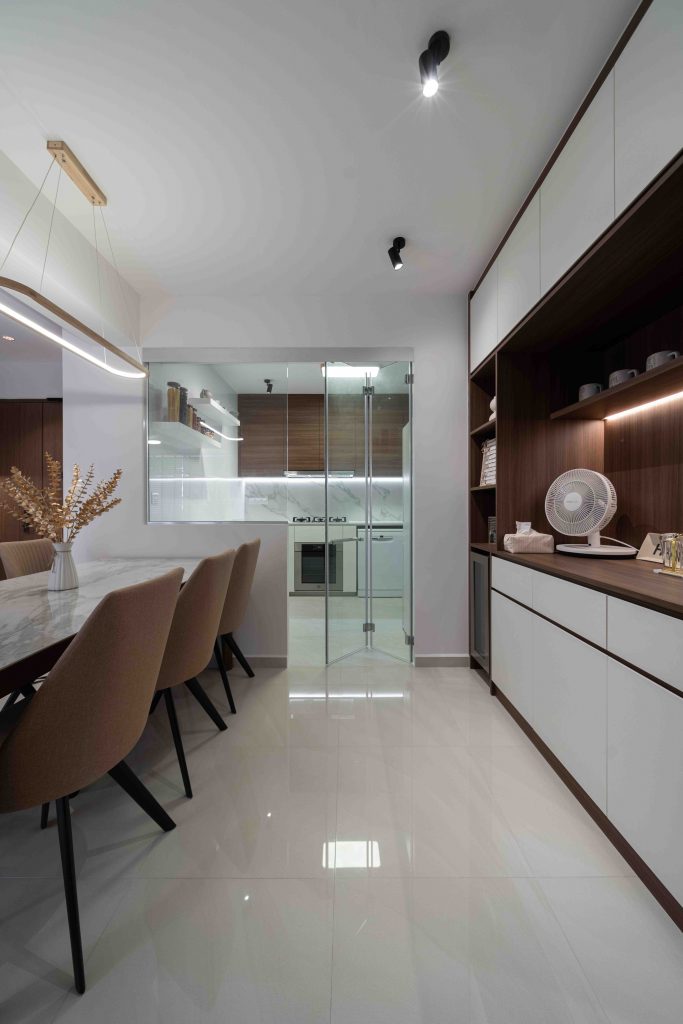Have you ever felt overwhelmed by the clutter in your home, longing for a space that whispers peace and simplicity? Welcome to the enchanting world of Wabi Sabi vs. Japandi, where minimalism meets tranquility, and every corner of your home becomes a sanctuary. These two interior design styles have surged in popularity, captivating hearts with their unique philosophies and aesthetics. But what sets them apart? And which one will best transform your living space into a haven of serenity?
Wabi Sabi vs. Japandi – both terms might sound exotic, yet they embody principles that resonate deeply with our modern-day quest for balance and simplicity. At Exqsite Interior, we understand the delicate art of blending these styles to create personalized, comprehensive renovation and interior design solutions that speak to your soul.
Let’s embark on a journey to explore the subtle nuances of Wabi Sabi and Japandi, delving into their distinct characteristics and uncovering the pros and cons that each style offers. By the end of this exploration, you’ll be inspired to choose the design philosophy that aligns with your vision of a harmonious home.

Wabi Sabi Style
Wabi Sabi is a Japanese aesthetic that emphasizes the beauty of imperfection, simplicity, and naturalness. It celebrates the essence of time, wear, and age in objects, and promotes mindfulness and tranquility. Here are some characteristics of Wabi Sabi style:
- Materials: Wabi Sabi style incorporates natural materials such as wood, stone, and linen in furniture and decor.
- Color Scheme: Wabi Sabi style favors a muted, earthy color palette that showcases age and wear.
- Furniture and Decor: Wabi Sabi style embraces the beauty of imperfection by incorporating vintage or antique pieces. It also emphasizes the use of handmade pottery and simple decorations that evoke a sense of intimacy and simplicity.
Pros and Cons of Wabi Sabi
Pros:
- Promotes mindfulness and tranquility
- Budget-friendly since it encourages the use of vintage or antique pieces
- Celebrates the beauty of imperfection
- Incorporates natural materials, which can help reduce stress and anxiety
- Provides a unique and personalized living space that reflects the individual’s tastes and experiences
- Adds character and depth to a space, making it feel more authentic and lived-in
Cons:
- May be difficult to achieve in a modern home, as modern homes tend to favor sleek and polished surfaces
- May require a lot of effort to balance imperfection and simplicity, resulting in a cluttered or chaotic look if not done carefully
- Vintage or antique pieces may be harder to find or may require more maintenance
- May not appeal to those who prefer a more uniform and polished aesthetic
- May require a certain level of knowledge and understanding of the philosophy behind Wabi Sabi in order to incorporate it into a space successfully

Japandi Style
Japandi is a hybrid design style that combines the Japanese aesthetic of Wabi Sabi with the Scandinavian minimalism of Hygge. It emphasizes functionality, simplicity, and harmony, and creates a calm and inviting atmosphere. Here are some characteristics of Japandi style:
- Materials: Japandi style favors natural and sustainable materials such as wood, bamboo, and leather in furniture and decor.
- Color Scheme: Japandi style uses a neutral color palette with muted pastel colors to create a calming and inviting atmosphere.
- Furniture and Decor: Japandi style incorporates furniture with clean lines and simple shapes. It also uses natural textiles and decorative items with a purpose that evoke a sense of coziness and harmony.
Pros and Cons of Japandi
Pros:
- Creates a calming and inviting atmosphere
- Emphasizes functionality and minimalism
- Encourages the use of sustainable materials
- Ideal for small spaces
- Easy to maintain and keep clean
- Incorporates natural elements, which can help reduce stress and anxiety
- Can make a room feel more spacious and airy
Cons:
- May lack personality and character
- Can be too minimalist for some people
- May feel too “cold” or sterile to some individuals
- Limited use of color may be boring or unappealing to some
- May require a lot of investment to purchase high-quality, sustainable materials
- Can be difficult to achieve a perfect balance between Japanese and Scandinavian elements, resulting in an unfinished look

Difference between Wabi Sabi and Japandi
While both Wabi Sabi and Japandi promote simplicity, naturalness, and harmony, they differ in philosophy and concept, color scheme, materials and textures, furniture and decor, and balance and harmony. Here’s a brief comparison table:
| Aspect | Wabi Sabi Style | Japandi Style |
| Philosophy | Emphasizes the beauty of imperfection | Combines Japanese and Scandinavian aesthetics |
| Color Scheme | Muted and earthy | Neutral with muted pastel colors |
| Materials and | Natural materials | Sustainable materials |
| Textures | such as wood, stone, and linen | such as wood, bamboo, and leather |
| Furniture and Decor | Vintage or antique pieces | Furniture with clean lines and simple shapes |
| Balance and Harmony | Imperfection and simplicity | Functionality and minimalism |
How to Incorporate Wabi Sabi
Incorporating Wabi Sabi into your home can be a challenge, especially if you live in a modern space. However, there are a few tips you can follow to achieve the desired aesthetic:
- Embrace natural materials: Use wood, stone, and linen in your furniture and decor. Opt for handmade pottery or ceramic bowls instead of mass-produced items.
- Choose muted colors: Wabi Sabi favors a muted and earthy color palette that showcases age and wear. Go for muted greens, browns, and grays to create a sense of calmness.
- Celebrate imperfection: Instead of hiding scratches or dents, embrace the beauty of imperfection. Use vintage or antique pieces, and let them show their age and wear.
- Keep it simple: Wabi Sabi is all about simplicity and intimacy. Choose decorations that evoke a sense of calmness, and avoid clutter.
How to Incorporate Japandi
Incorporating Japandi into your home is easier than Wabi Sabi, but it still requires some thought and planning. Here are some tips:
- Use natural materials: Japandi favors natural and sustainable materials such as wood, bamboo, and leather. Avoid synthetic materials and choose sustainable options.
- Stick to a neutral color palette: Japandi uses a neutral color palette with muted pastel colors to create a calming and inviting atmosphere. Go for light grays, blues, and greens.
- Choose furniture with clean lines: Japandi style emphasizes functionality and minimalism, so choose furniture with clean lines and simple shapes. Avoid overly ornate or decorative pieces.
- Add cozy elements: To create a sense of coziness, add natural textiles such as wool or linen, and choose decorative items with a purpose.
Choosing between Wabi Sabi and Japandi comes down to personal preference and lifestyle. If you prefer a more rustic and intimate space, go for Wabi Sabi. If you prefer a more modern and functional space, go for Japandi. Both styles promote simplicity, naturalness, and tranquility, making them perfect for those who seek a calm and inviting living space.
Discover the beauty of imperfection with Exqsite interior design service
20 years of professionals’ experience.
In Exqsite, our team of 20 years of professional experience will make your house beautiful and functional in every aspect, with an eye on detail and perfection. We guarantee you will be satisfied! Here are things that you will get from us:
- We provide high-quality workmanship at reasonable prices
- We put our clients first by serving them friendly customer service
- Employees with over 20 years of experience
Make your renovation situation easier with us. Click here or visit our showroom at 8 Boon Lay Way Tradehub21 #01-18 Singapore, Singapore 609964 for the solution to your renovation problems.

